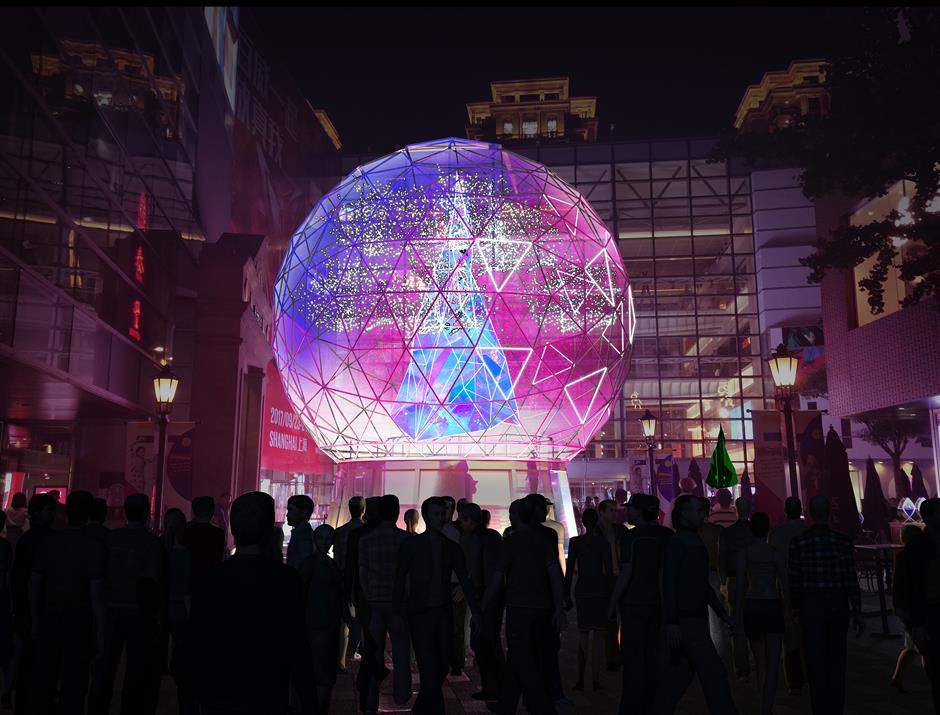Xintiandi's Christmas tree: Come inside and play

An artist's rendition of crystal globe-shaped Christmas tree
Xintiandi’s ground-breaking interactive Christmas tree — which visitors can go inside and change the appearance of — is changing the stereotype of the traditional shape and function of a Christmas tree.
It is a 15-meter-high, visually stunning crystal globe-shaped tree that was launched on November 22 in a lighting ceremony to open this year’s Christmas celebrations in Xintiandi, entitled “Rolling X.”
The tree — more accurately, a tree inside a giant snow globe — at South Block Plaza is an exquisite combination of art and technology.
Unlike traditional Christmas trees, it is “an immersive and interactive playground for the public.” Through January 7, visitors can go inside the tree and play in a large white ocean ball pool.
They can also interact with the crystal globe and create different lighting effects from inside out. At 8pm and 10pm daily, the tree will also set the stage for spectacular laser light show.
The work is a collaboration between Shanghai Xintiandi and Dogma Lab, a cross-disciplinary media and design consultancy.
Dogma Co-founder Benjamin Bacon was the lead designer. He is a creative technologist, designer and professor of computational and media design at the Shanghai Institute of Visual Art.
Bacon was the former director of the undergraduate Design + Technology program at Parsons The New School for Design in New York.
He has also been a professor at several top international universities. He has more than 10 years' experience as a musician and DJ across the United States, Europe and China, and has exhibited and lectured in North America, Europe, Asia and the Middle East.
Bacon is also founder and resident musician of “Voltage Divider,” a series of music and media events in Shanghai exploring experimental and avant-garde musical styles.

Benjamin Bacon, co-founder of Dogma Lab and lead designed of the boundary-breaking Christmas tree
Q: What inspired this design?
A: We developed the concept of the globe alongside our (New York-based) counterpart interactive studio ─ Anyways, Here’s The Thing.
Q: What the message do you want to convey?
A: This year’s Christmas tree is more than just a tree. It is an immersive experience that takes the audience on a journey through interactive light, music and a textural celebration of the Christmas season and emotion.
Christmas means many different things to different peoples. For some, it’s a time for family and friends, and we hope to enhance this experience with the 2017 Christmas Snow Globe.
Q: What’s the unique charm of your version of the Christmas tree?
A: I think the most unique part of the Christmas tree is the immersive experience the users will have when they enter the globe and are surrounded by lights, color, touch and other sensation.
Q: What are the technical elements? How can people interact with it and achieve a fabulous experience?
A: The tree is interactive; we have four places inside it where the audience can use the touch panels to light up the tree. This also creates a generative musical ambience. Last but not least, the slide and ball pit is not just for kids!

Q: How long did it take you to design and make this? What were the major challenges for you and your team?
A: The whole design process ─ from concept to final installment ─ was about nine months. The biggest challenge was the unpredictability that came with the complexity of the project. But all the partners have been amazing at solving and quickly overcoming these hurdles.
Q: Dogma Lab has presented many stunning works. Which projects are you most proud of?
A: Vivian Xu’s Electric Skin Project and my own Magnetic Body Instrument. (The Electric Skin project is a wearable item that senses electromagnetic fields, while Magnetic Body Instrument uses the human body, with magnets, to create music.)
Q: What is the relationship between art and technology?
A: The relationship between art, technology and science is a melting pot of ideas and creativity that go hand-in-hand together.
Q: You also have created experimental works in art, music and performance. It seems that art has no boundaries for you. How do you see the future of art in China?
A: Art is culture and culture creates art. It will always be a part of us, both in China and the rest of the world, and I believe that brings us all closer together.
















